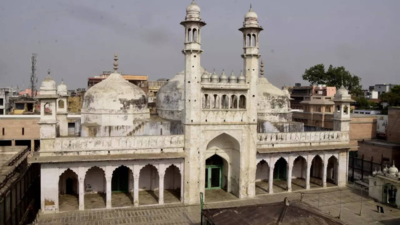
VARANASI: Challenging the claim of the Anjuman Intezamia Masajid that Gyanvapi Mosque was a waqf property, the lawyers of five women plaintiffs claimed that Gyanvapi was never a mosque and was standing on the ruins of a temple. Hearing on maintainability of the plea filed by five women plaintiffs seeking right to worship Shringar Gauri and other deities in Gyanvapi Mosque compound concluded at the court of district judge here on Wednesday. District judge Ajay Krishna Vishvesha has fixed September 12 as the date for delivering his verdict on the maintainability of the case.
‘AIM’s claim is a fraud & a bid to mislead court’
Giving this information, district government counsel (civil) Mahendra Prasad Pandey told TOI that the arguments and counter-arguments by the plaintiffs and AIM on the issue of maintainability of the case came to an end at 3.15 pm on Wednesday.
Shamim Ahmed, senior lawyer of AIM – the Gyanvapi mosque management committee – started the final round of arguments at the district judge’s court at 11.30.
A member of the AIM advocates’ panel, Rayees Ahmed, said, “Today (Wednesday) we presented our submission on the issues of applicability of the Places of Worship (Special Provisions) Act, 1991 and contents of the Kashi Vishwanath Temple Act, 1983.”
“We explained that the KV Temple Act, 1983, contains only the name of Kashi Vishwanath Temple and not ‘old or new’ temple. Also, only the property endowed to KV Temple is mentioned in it and there is no reference to the mosque,” he said.
Regarding applicability of the Places of Worship (Special Provisions) Act, 1991, Rayees Ahmed said, “We mentioned that in our previous arguments we had proved that the Gyanvapi mosque, which is also known as the Alamgir mosque, is a waqf property as per the decision in Deen Mohammad Vs secretary of state case 1936, high court order of 1945 and gazetting by the then district magistrate in 1944. We proved that on August 15, 1947 it was a mosque and a waqf property, hence the Places of Worship (Special Provisions) Act 1991 applies to it.”
After AIM concluded its submissions, veteran Supreme Court advocate Hari Shankar Jain, who is contesting the case on behalf of four women plaintiffs – Laxmi Devi, Sita Sahu, Manju Vyas and Rekha Pathak – started the counter- arguments. “We mentioned that the AIM’s claim that Gyanvapi and Alamgir mosques are the same is a fraud and a bid to mislead the court. Alamgir mosque is separate and exists at Madhav Bindu, Panchganga Ghat. Gyanvapi has never been a mosque,” he told TOI.
Jain said, “We submitted in the court that even after the demolition of the temple by Mughal Emperor Aurangzeb, the Hindus continued worshipping at Shringar Gauri and other deities in the ruins of Gyanvapi. In fact, Hindus had been worshipping there on August 15, 1947, and continued the practice till Gyanvapi was isolated with steel barricading in the name of security by the Mulayam Singh Yadav government in 1993. Thus, Gyanvapi is not barred under sections of the Places of Worship (Special Provisions) Act, 1991.”
Maan Bahadur Singh, advocate of plaintiff number one, Rakhi Singh, said: “I informed the court that any property is dedicated for waqf by its owner with pious purpose and Aurangzeb was not the owner of the property. Gyanvapi is a disputed structure as it stands over a temple’s ruins. Hence, it is not barred under the Places of Worship (Special Provisions) Act 1991.”
As per the directive of the Supreme Court to decide the maintainability of the case No 692/2021 Rakhi Singh vs state of UP and others on priority, district judge Ajay Krishna Vishvesha had started hearing the matter from May 20.
FacebookTwitterInstagramKOO APPYOUTUBE